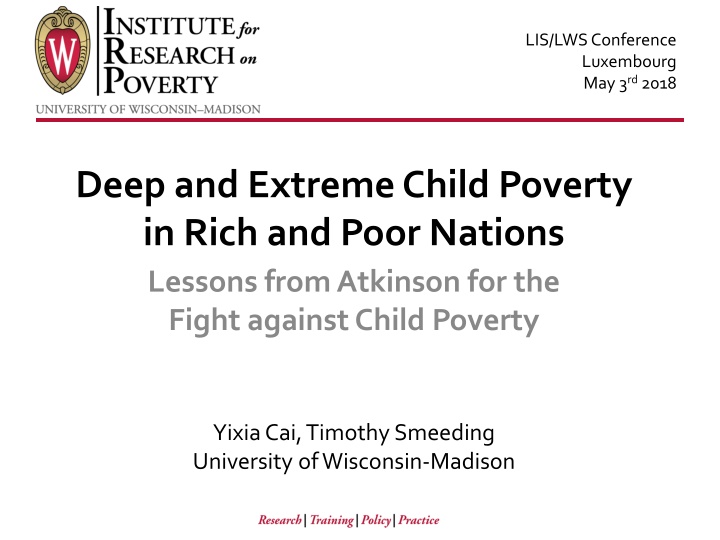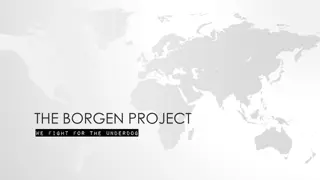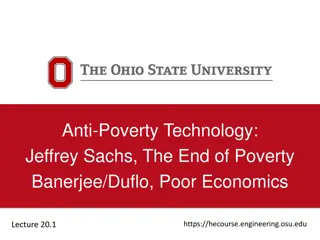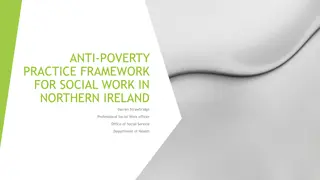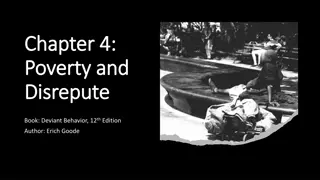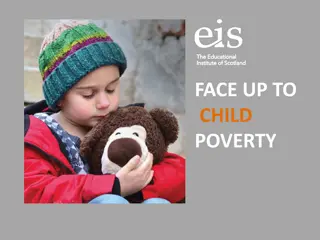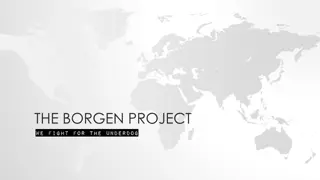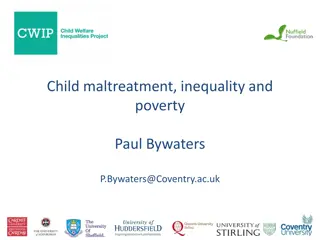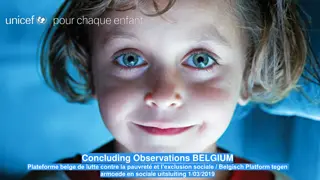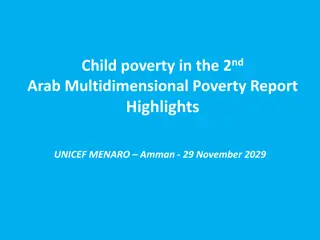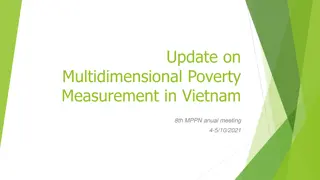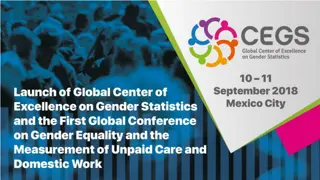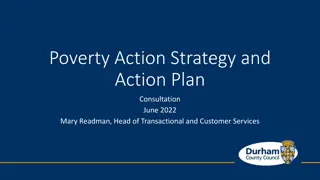Child Poverty Analysis: Lessons for Global Action
Explore the deep and extreme child poverty issues across rich and poor nations, drawing insights from discussions on child poverty, Millennium Development Goals, sustainable development goals, and historical income classifications among middle-income countries. Discover the roles of labor markets, private transfers, and public benefits in tackling child poverty. Gain valuable perspectives on the policy responses of nations like Brazil, China, South Africa, and the US towards combating deep child poverty.
Download Presentation

Please find below an Image/Link to download the presentation.
The content on the website is provided AS IS for your information and personal use only. It may not be sold, licensed, or shared on other websites without obtaining consent from the author.If you encounter any issues during the download, it is possible that the publisher has removed the file from their server.
You are allowed to download the files provided on this website for personal or commercial use, subject to the condition that they are used lawfully. All files are the property of their respective owners.
The content on the website is provided AS IS for your information and personal use only. It may not be sold, licensed, or shared on other websites without obtaining consent from the author.
E N D
Presentation Transcript
LIS/LWSConference Luxembourg May 3rd2018 Deep and Extreme Child Poverty in Rich and Poor Nations Lessons from Atkinson for the Fight against Child Poverty YixiaCai,TimothySmeeding University ofWisconsin-Madison
Overview Why should we care? Issues surrounding child povertyin a global context Deepchild poverty& Extreme child poverty? Methods and measures What do we learn? levels and trends of child poverty across 9 countries Disaggregate income package What could be done?
Millennium developmentgoals Sustainable development goals (SDGs) Tackling extreme povertyis always the #1target Some data and methods that are not suitable to measure poverty in rich countries Family size adjustments used by the World Bank assume no economies of scale in household consumption
What we do? Landmark study Monitoring Global Poverty Estimate data trends deep (relative) and extreme (absolute) child poverty MICs: Brazil, China, India and SouthAfrica HICs: Australia, Canada, Ireland, UKandUS Recognize the roles of the labor market, private transfers and public benefits
Historical classification by income among 4 middle-income countries 2002 2004 2006 2008 2009 2010 2011 2012 2013 2015 Brazil LM LM UM China LM LM LM LM LM UM India L L L LM RSA LM UM
Why these 4 middle-income nations? More than 70 percent of the global poor live in MICs Over 30% of the world s poorest children live in India Over 50% of the nation s children live in poverty in South Africa High level of resource inequality Policy response Positive effects of conditional cash transfer programs (Brazil, SouthAfrica), child support grants(SouthAfrica) andanti- poverty policy (China)
Why these 5 rich nations? Deep child poverty continues to persist AngusDeaton points tothe extremedisadvantage in theUS $2adaystory and Alston UN report Policy response Among the 5 countries, all but the US have a universal ornear- universal child allowance IntheUS, income support is increasingly transferred from the desperately poor with little or no earnings to the working poor Recent call forreducingaccessto alreadysmall safety nets
Setting the poverty line Relative (Deepchild poverty) (1)Halfofthe international relative measure 25% of national median equivalized income (2)Half oftheUS supplementalpovertymeasureline (USSPMwasestimated tobe close to40% of the median national adjusted income in the USA s most recent data in LIS Database) 20% of nationalmedian equivalized income For cross-national comparison, weuse: 25%line for MICs 20%line for HICs
Setting the povertyline Absolute(Extremechild poverty) ? ??= ?? ?????+ ? ?? ? ??? (1) Per-capita scale (2) LIS square-root scale $2, $4, $6a day ?????? ?? ????????????? $ ??? ???? ? =?????? ?? ????? ????????? ???? 100 2011??? ???? ???? ??? ???? ? =????? ???? ????/100
Deep child poverty across middle-income countries (25% of national median equivalised disposable income) 14 BR CN IN SA 12 10 8 6 4 2 0 2002 2004 2006 2008 2009 2010 2011 2012 2013 2015
Deep child poverty across high-income countries (20% of national median equivalised disposable income) 5 AU CA IE UK US 4.5 4 3.5 3 2.5 2 1.5 1 0.5 0 2003 2004 2007 2008 2010 2013 2016
Extreme child poverty across middle-income countries ($2 a day) 90 90 80 80 Percent based on LIS equivalence scale Percent based on per-capita scale 70 70 60 60 50 50 40 40 30 30 20 20 10 10 0 0 2002 2004 2006 2008 2009 2010 2011 2012 2013 2015 CN IN SA BR BR* CN* IN* SA*
Extreme child poverty across high-income countries ($4 a day) 2 2 Percent based on LIS equivalence scale 1.5 1.5 Percent based on per-capita scale 1 1 0.5 0.5 0 0 2003 2004 2007 2008 2010 2013 2016 CA IE UK AU US AU* CA* IE* UK* US*
Reductions in deep child poverty across high-income countries Australia 2008 2010 Poverty based on market income + private + SI+ UB + means-tested transfers Canada 2004 2007 2010 Poverty based on market income + private + social insurance + universal benefits 2013 Ireland 2004 2007 2010 UK 2004 2007 2010 2013 Poverty based on market income + occupational pension Poverty based on market income + OP+ private transfers US 2004 2007 2010 2013 2016 0 5 10 15 20 25 30
Reductions in deep child poverty across middle-income countries Brazil 2006 Poverty based on market income + private + SI+ UB + means-tested transfers 2009 Poverty based on market income + private + social insurance + universal benefits 2011 2013 Poverty based on market income + occupational pension China 2002 2013 SA 2008 2010 2012 Poverty based on market income + OP+ private transfers 2015 India 2004 2011 0 5 10 15 20 25 30 35 40 45
Reductions in extreme child poverty across high-income countries Australia 2003 Poverty based on market income + private + SI+ UB + means-tested transfers 2008 2010 Canada 2004 2007 Poverty based on market income + private + social insurance + universal benefits 2010 2013 Ireland 2004 2007 2010 UK 2004 2007 Poverty based on market income + occupational pension 2010 2013 Poverty based on market income + OP+ private transfers US 2004 2007 2010 2013 2016 0 5 10 15 20 25 30
Reductions in extreme child poverty across middle-income countries Brazil 2006 Poverty based on market income + private + social insurance + universal benefits 2009 Poverty based on market income + private + SI+ UB + means-tested transfers 2011 2013 China 2002 2013 Poverty based on market income + occupational pension SA 2008 2010 2012 Poverty based on market income + OP+ private transfers 2015 India 2004 2011 0 10 20 30 40 50 60 70 80
Percentage of deep child poverty reduction that each component accounts for 100% 0.02 0.29 0.37 80% 0.51 0.62 0.63 0.65 0.76 60% 0.92 40% 0.71 0.61 0.42 0.24 0.30 0.33 20% 0.07 0.16 0.11 0.07 0.07 0.06 0.05 UK(13) 0.02 BR(13) 0% AU(10) CA(13) IE (10) US(16) IN(11) SA(15) Private transfers Social Insurance+Universal Programs Means-tested transfers-tax
What do we learn and what could be done? A substantial reduction in child poverty in MICs Public benefit became more prevalent in recent year Private transfers and remittances benefit the poorestkids Higher child poverty rates in theUS Universal programs in the US tend to be meager Universal child benefit is needed
Extreme child poverty across high-income countries (LIS square-root scale) 1.6 1.4 1.2 1 Percent 0.8 0.6 0.4 0.2 0 2003 2004 2007 2008 2010 2013 2016 $4 AU $4 CA $4 IE $4 UK $4 US $6 AU $6 CA $6 IE $6 UK $6 US
